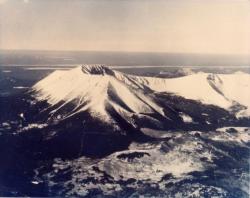Their sexual abstinence, gender segregation, and withdrawal from the wider society set them apart from the rapidly industrializing and urbanizing America of the 19th century. Their rural self-sufficiency and entrepreneurial spirit often overcame the suspicions of their neighbors as they settled into communities organized around "families" of carefully and ritually controlled members dedicated to a faith of practical purpose — work, charity, utility, self-reliance, and simplicity.

Sisters and girls, Sabbathday Lake Shaker Village, ca. 1902
United Society of Shakers
Maine hosted three Shaker communities with a shared membership of a several hundred. Arriving in Maine early in the 1780s they settled in the somewhat isolated areas of Alfred, Gorham, and Sabbathday Lake (then called Thompson's Pond) at New Gloucester.
Their religious underpinnings and related practices sustained these communities and generally kept them focused on their mission – creating a heaven on earth for the elect.
Believing in a community of goods as well as of souls, Shakers shared all material supplies, lived in group housing, cared for the aged and infirm as part of their service ethic, and offered both security and leadership possibilities to resident Believers.
Nearly all Shaker communities suffered a decline after the Civil War. The Shakers of Alfred turned over their land and buildings to a Christian brotherhood during the early years of the Depression, and moved to New Gloucester to join the remaining members of the Sabbathday Lake community. Sabbathday Lake remains the only active community of Shakers in the country.

Mount Katahdin, ca. 1960
Southern Aroostook Agricultural Museum
Culture of Memory
While the Shakers were inveterate record keepers, they also used songs, rituals, and "spirit drawings" to preserve and communicate larger meanings. Native peoples relied heavily on participatory visual –– dances, rituals, sacred colors and patterns – and oral – songs, chants, prayers, and stories --– communications for sustaining their societies and for transmitting their cultural traditions.
The Maine landscape, as well, was more than just a location for material resources, it was also marked by sacred spaces like Mount Katahdin in the interior and petroglyph sites along the coast whose use and meaning have remained culturally significant even if a full understanding eludes scholars.
Organized around villages, clans, and hunting bands, Native Americans also sponsored warrior societies, competitions, communal festivals, and political organizations. Games and other pursuits tested individual abilities and reinforced group traditions. Micmac, Penobscot, Passamaquoddy, and Maliseet peoples gambled for sport (one game was played with flat dice, a wooden bowl, and counting sticks for keeping score).

Penobscot Tribal members, Sugarloaf Mountain, 1980
Maine Historical Society
Maine Indians occasionally hosted friendly athletics contests, like lacrosse, amongst neighboring bands designed to showcase skills, such as endurance and accuracy, needed in hunting and war.
Community bonding derived from the small size of native societies, their interdependence, and coherent traditions. For the Wabanaki peoples, maintaining traditions amidst the complications of European settlement, subsequent wars, and near complete marginalization by the United States and the state of Maine necessitated a commitment to identity of heroic proportions.
But it also worked the other way around — native traditions sustained the people, providing a core around which to reconstitute their society, and a cause that committed them to a future more secure than their recent past.
Non-native populations also have relied on oral traditions, along with many other tools, to remember the past and use it for present needs – keeping communities together, enforcing social norms, and coping with changing situations.
Old Home Days celebrations work to preserve a community's sense of community and repackage the past, not only as nostalgia, but also as a useable base for the future. Monuments and statues to soldiers, to heroes and heroines, and, sometimes, to ordinary citizens who are emblematic of the community also frame past experiences for current and future generations.

Old Home Week, Houlton, 1907
Aroostook County Historical and Art Museum
The monuments, and often parades on patriotic holidays, help to steer historical memory to particular narratives that can serve to set limits on a community's identity and the behavior of individuals within it.
Memory is preserved in many other ways as well – written and visual accounts, lectures, movies, activities of historical societies, and many more. The cultural, religious, social, and educational institutions Mainers form all contribute in various ways to the construction of memory as well as to community.












